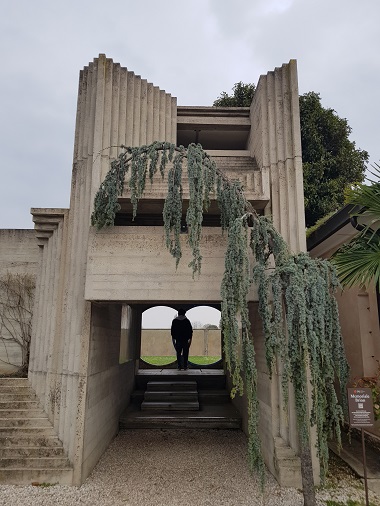 |
 |
|||||||||||||
|
Editorial Just a detail friends would see
By Toh Hsien Min
Round the corner from my apartment is Apartment Coffee, supposedly Asia's best coffee shop and in sixth place globally on the World's 100 Best Coffee Shops 2025 list. I go often enough to know the names of the staff there, but it's not my weekly regular. Don't get me wrong, the coffee is good, but my best visits there are on weekday mornings when there isn't a queue, let alone a crowd, and then the Scandi-Japanese minimalist vibe shines. One of the major backers is an architect who also collects art, so some of his art pieces cycle through the place. My favourite is the cheerful, pastel Wakaru behind the cashier, but one morning a couple of years ago, what caught my eye was a framed art photograph on the far wall near the back exit that no longer opens out into the alley to allow me a much shorter walk to and from home. The photograph was a black-and-white one of a cemetery, artistically composed with two rings in the background and graves in the foreground. From the central table, I could already guess from the style of the cemetery that it was either Italian or (less likely) wealthy South American. When I walked over to examine it closely, the names on the graves made it clearly Italian, and something about the detail made it seem northern Italian to me. I asked A. at Apartment, but she didn't know, said it was the owner's piece. So when I got home I started googling "northern Italian cemeteries" in the hope of solving the mystery. It didn't take me long. So earlier this year, when I decided to revisit northern Italy in advance of crossing another milestone in my life, the Brion-Vega was the top destination on my list. It was a memorable visit. The architecture of Carlo Scarpa - led by geometric, repeating forms - made for poetry in concrete. The sense of the moment in entering the propylaeum through its low entry into the miniature watchtower edged by patterned lines, which, according to Scarpa, underlines the significance of the gateway, and then the two intersecting circles letting a dominance of light into the dim concrete felt almost like a metaphor for the moment of death. Indeed the architecture of the Brion-Vega was a huge draw, but when a friend asked me about my visit recently I realised that in spending all my time with Scarpa's memorial, I had actually neglected the regular Italian graves that had been an equal part of the photograph. The Brion-Vega was almost the cemetery as non-cemetery.  This was an odd realisation because my obsession with cemeteries is exactly about their being cemeteries. I don't know if I've visited more cemeteries than vineyards on my travels, but I imagine the numbers are fairly close. In Paris, besides the Cimetière du Père Lachaise, I've done the lesser cemeteries such as Montparnasse and Montmartre. I've kept the cab waiting at Cottingham Municipal Cemetery while I went on a mad dash to locate the grave of Philip Larkin (this was before the age of mobile phones, so if I had let go of the cab I would have faced a very long walk back to Hull). In Chile, I visited cemeteries in Valparaíso and Puerto Natales and especially the Sara Braun Municipal Cemetery in Punta Arenas, which was not only extremely beautiful but where Charlie Milward, who inspired Bruce Chatwin's In Patagonia is buried. In Rome I searched out the Protestant Cemetery in Testaccio to see the grave of John Keats and its inscription: "Here Lies One Whose Name Was Writ in Water". I've visited the New Zealand Military Cemetery in New Caledonia which looks like a golf fairway curving into a view of the hills, the ale Cemetery designed by Joe Plečnik in Ljubljana, a clutch of WWI cemeteries in Belgium, the Cahuachi cemetery in Peru where bones are literally rising out of the sand, the New Jewish Cemetery in Prague where Kafka is buried (but also the Olany Cemetery). Cemeteries like supermarkets reflect their different cultures. In the Pacific (New Caledonia / Ouvéa / Easter Island), the local cemeteries are very rudimentary but the graves are adorned with almost over-the-top colours by visitors to the graves. In the Cinque Terre, the cemeteries in all five towns are at the highest point linked to the town before the pathways head up into the hills; similarly on Inis Oírr the cemetery was on a hillock with a clear view out to the ocean, whereas the extensive St Paul's Catacombs in Malta have dug deep into the limestone to safeguard the dead better. But through it all runs a common thread. Overall I have a great sense of calm while wandering through cemeteries, unreplicated elsewhere. I think it's simply that memento mori places everything in perspective. As Psalm 90 says: "Teach us to number our days, that we may gain a heart of wisdom." Or, translated by Larkin for the less religious: "this ground, / Which [...] was proper to grow wise in, / If only that so many dead lie round". I wasn't intending to be morbid; I blame the usual last minute dash for an editorial topic. But this issue could not be more different. There is plenty of life, with a golden retriever dashing in betweeh a ghost and a fairytale in the poetry, along with a stunning view of holding on to life in the aftermath of an accident. The short stories feature a baby engineered to live forever and an Arab oasis away from the daily bustle. Criticism, as ever, is lively in the discourse between reader and writer, and then Proust this issue is - well, let's just say it throbs so much with life that it threatens to jump off the page. QLRS Vol. 24 No. 3 Jul 2025_____
|
|
|||||||||||||
Copyright © 2001-2025 The Authors
Privacy Policy | Terms of Use |
E-mail